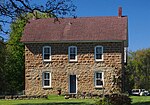Episcopal Church of the Transfiguration (Belle Plaine, Minnesota)
1869 establishments in Minnesota19th-century Episcopal church buildingsBuildings and structures in Scott County, MinnesotaCarpenter Gothic church buildings in MinnesotaChurches completed in 1869 ... and 6 more
Churches on the National Register of Historic Places in MinnesotaEpiscopal church buildings in MinnesotaMinnesota Registered Historic Place stubsMinnesota church stubsNational Register of Historic Places in Scott County, MinnesotaUse mdy dates from August 2023

The Episcopal Church of the Transfiguration, an Episcopal church building in Belle Plaine, Minnesota is a Carpenter Gothic style building with wooden buttresses. Sometimes referred to as a "prairie Gothic" church, it was built in 1868 for English-speaking parishioners, but most of the rural residents at the time were German and Irish immigrants who brought their own languages and religious practices with them. The result was a church building that struggled to attract worshipers for 80 years before it was abandoned. It is listed on the National Register of Historic Places.
Excerpt from the Wikipedia article Episcopal Church of the Transfiguration (Belle Plaine, Minnesota) (License: CC BY-SA 3.0, Authors, Images).Episcopal Church of the Transfiguration (Belle Plaine, Minnesota)
North Elm Street,
Geographical coordinates (GPS) Address Nearby Places Show on map
Geographical coordinates (GPS)
| Latitude | Longitude |
|---|---|
| N 44.624444444444 ° | E -93.763055555556 ° |
Address
North Elm Street
56011
Minnesota, United States
Open on Google Maps




